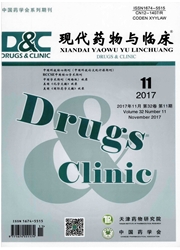

 中文摘要:
中文摘要:
目的通过观察痛风颗粒各部位对高尿酸血症大鼠血尿酸、尿尿酸、血黄嘌呤氧化酶活性和肝脏黄嘌呤氧化酶活性的影响,探讨其治疗痛风的物质基础和机制。方法以腺嘌呤合乙胺丁醇法诱导大鼠高尿酸血症模型,分别用磷钨酸法和酶比色法检测尿酸和黄嘌呤氧化酶的含量。结果黄酮类成分在降尿酸和抑制黄嘌呤氧化酶活性上均起主要作用;生物碱类成分对尿中尿酸的排泄和血清黄嘌呤氧化酶活性的抑制起较重要作用,有机酸类成分均未表现出明显作用;全方和有效部位组合有明显的降尿酸和抑制黄嘌呤氧化酶活性的作用。结论黄酮类、生物碱和有机酸类有效部位组合后的药效与处方药一致,是该处方的有效部位群,对高尿酸血症模型大鼠表现出的降尿酸和抑制黄嘌呤氧化酶活性的作用最为显著。
 英文摘要:
英文摘要:
Objective To discuss the material foundation and mechanism of Tongfeng Granule by observing the effects of various fractions in Tongfeng Granule on the blood uric acid (UA), urinary UA, blood xanthine oxidase (XOD) activity and liver XOD activity of hyperuricemic rats. Methods The hyperuricemia rat model was established by adenine and ethambutol, and the contents of UA and XOD were determined with phosphotungstic acid method and enzyme colorimetric method, respectively. Results The flavonoids played the leading roles in dropping UA and inhibition on XOD activity; The alkaloids in the excretion of UA urine and restraining serum SOD activity played the more important role, but organic acids had no obvious effect. Prescription and effective parts combination had obvious activitied in dropping UA and inhibition on XOD activity Conclusion The effective parts of orthogonal design research shows that the combination of flavonoids, organic acids, and alkaloids is the strongest to anti gout. A combination (flavonoids, alkaloids, and organic acid) shows the active role in droping UA and inhibition of XOD in hyperuricemia model rats.
 同期刊论文项目
同期刊论文项目
 同项目期刊论文
同项目期刊论文
 期刊信息
期刊信息
